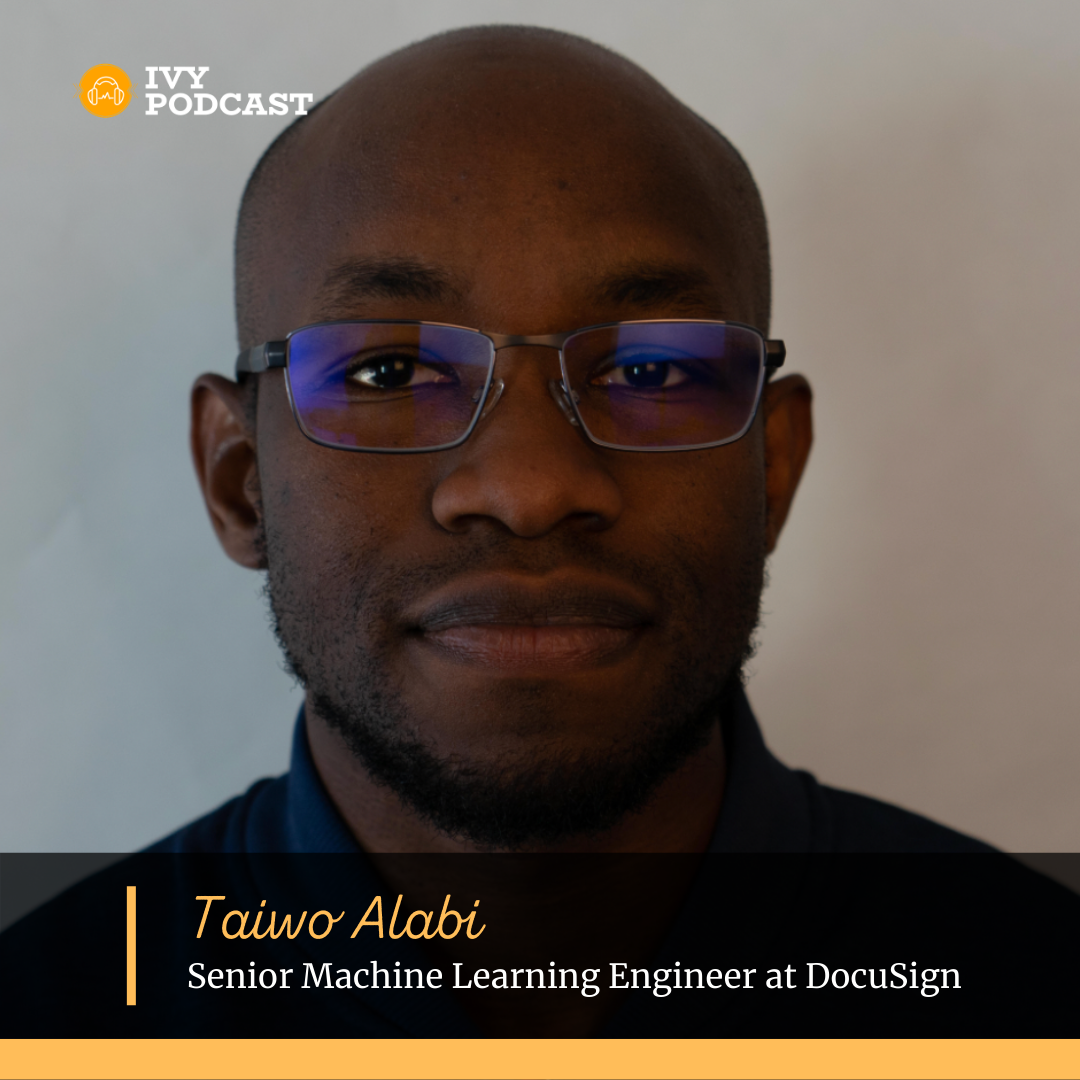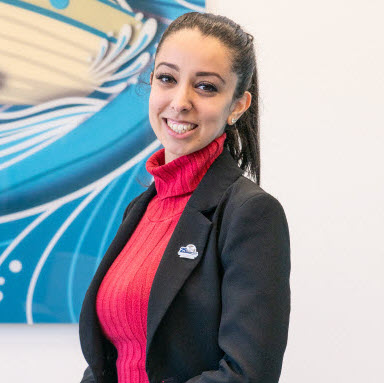
Dr. Taiwo Raphael Alabi is multilingual with an education spanning 3 continents at some of the best engineering schools in the world.He has spent his entire career in electronic and software engineering at Intel and DocuSign. With multiple highly cited publications in the field as well as 3 pending US patents, he currently drives narrow artificial intelligence initiatives at DocuSign. Some of his primary focuses in the field of AI are natural language processing, computer vision, recommender systems, and reinforcement learning. His interest also spans meta-learning and machine learning systems design. He enjoys traveling, hiking, obstacle racing, playing the guitar, and chasing after new challenges in his limited free time.
Episode transcription:
F: Thank you for joining us today, Taiwo. T: Thank you for having me, Fred. F: Awesome. First question. What was it that drove you to get involved in the machine learning field and for the sake of our listeners who may be unfamiliar with machine learning, you mind describing that as well? T: Yeah, definitely. I will go to the last question for our, so what is machine learning? I like to define machine learning as the art of finding information. From data and it could be any kind of data. It could be massive data, small data, but just finding that information or that insight from that data and being able to use that insight to benefit an organization, a country or a course that to me is meshing. F: And what drove you to machine learning? T: Actually, that's a very interesting question for me. I think what drove you to Michelle learning. Taking a couple of years, years back now, which is probably like five years back. I used to work at Intel and while I was at Intel, I was one of the lead engineers that drove a concept then five years ago, which was kind of new, then internet of things. We started that project. And when I started a project, one of the pinpoints of that project was that. This was going to be the next revolution. And it was going to drive degeneration of massive amount of data on a scale that nobody else has ever seen. And that once this happened or happens, then there's going to be a need for ways to harness that data and the fact that it was going to be that explosion, that was what drove me to. Understand, even more about what IoT was going to curse. And because of that, I started looking at so many journal articles and lo and behold, I found FMLA that machine learning and artificial intelligence, narrow AI, strong AI. We're going to be the eventual solution to data explosion, and that curiosity drove me to multiple different universities. I eventually went back to school, Berkeley, and even now Stanford, just to try to understand ways whereby we can harness that data. And the curiosity obviously is what has driven me to become much more of a bit. Well, I'm an expert in this field, just because I want to understand how we can harness East sites from data major trends in artificial intelligence that you foresee dominating the industry within the next five years. That's actually a very interesting question. I think in the next five years, taking a look at where we're at today and you can probably already foresee what will be experiencing the next five years. So I expect that, since I started five years ago from IoT out, IoT is going to eventually explode within the next five years. And I expect that it's going to be a lot of information out there, information from edge computing, devices, information from even cars, et cetera. I think there's going to be, we'll probably be generating as much information, which is happening today as we've generated within the past, probably 10, 20 years probably generating those in two years. Within the next five years. And then we'll also see the scene. We're going to be getting slowly to the age of basically strong AI. So right now what we have is mainly narrow AI. So narrow AI in this sense is basically aspects of AI that can do what they know how to do and what they can do it well. So like natural language processing, being able to understand humans, sentiment, et cetera, but now generalizing that to, well, you have a robot that can understand human sentiments. I can also identify human faces. So then we're not providing too much more strong AI whereby AI itself is not becoming much more autonomous. So the age of self-driving cars and et cetera, those are things that I see becoming much more real life or. Showing what real human benefits, but the next five years. So they don't, they're no longer like research terminologies, but yeah, actually walk in or they are in our everyday life and we're using them. We're just our, well, what they're doing, basically, they become tools that we use everyday. Just like we use cars today without actually realizing that they are artificial intelligence products or outcomes. F: I actually liked the example you just provided about self-driving cars. Do you have any specific use cases that you can share with us on how the data goes from the data acquisition and harnessing all the way to how that translates into self-driving cars? Any high-level experience that you can? T: That's a very good question. So dove self-driving cars, technology be the main brain behind self driving cars. Technology is basically the sensors and eventually the algorithms that run the information from the sensors. So different sensors for motion detection or just detecting distances between. Your car and the next car, the car next to you, and then you have all the other sensors, which in this case cameras, which physically give you inflammation and visual information about the environment. So, from harnessing data to actually being able to create a self-driving car type technology, so you can think of it, but just a basic, just let's just break it down into smaller concepts. And I'll probably talk about just one concept. Let's think of the concept of actually sharing the will of the car. So, well, you should be able to steer the wheel of a car. You need to be able to know if there's a person in front of you, or if there's an obstacle in this case, let's ask the interpersonal. Obviously there's an obstacle in front of you. If there is maybe a stop sign, if there is a traffic light, et cetera. Now, seeing all of this we can eventually identify all of these features in an image which you can capture in a camera. Now the camera walking in the real, in real time is processing many, many images. And those many images, you can pause them through what is called a convolution on your network, which is a visual whole recognition algorithm that can eventually tell. The driver or in this case, the algorithm, the algorithm that does the sharing of whether there is an obstacle in front of it or not. And so if it actually sees a stop sign, the algorithm has been processed to, okay, well, there's a stop sign, probably you need to stop. And then he sends that information from the steering wheel. I mean, all the way to the steering wheel and eventually also true to the rate, the SRO tracks, et cetera of the car and tells the cat to stop. So the cat stops well, in the situation whereby actually see an obstacle in front of you let's, as in the obstacle is a car now, and then probably the next step for the algorithm now is to tell the steering wheel to turn by specific number of degrees so they can physically not crash into that obstacle. So there's just so many different sensor type technologies or feedback loops whereby you see a signal where a signal in this case can be either a stop sign, or it could even just be lines on the road that tells a guy, Hey, guess what? You are driving in the right direction. So because of that, you need to keep the steering wheel angle to be at this. Same neutral position rates in or well, guess what you're, this private in a way from the central position you're supposed to be in. And because of that, I can see that it aligns that becoming much more diagonal. And so we need to actually get the driver or the steering wheel now to Tony in a different direction or a different in a counterclockwise direction or clockwise Russia as the case may be. F: So that's a very high level explanation. I mean, I can look more details if people want, but it's just a concept of just visual, um, visually recognizing or visual stimulus as well as sensor sensory stimulus in terms of like distance and being able to adjust parameters, including the steering wheel, including the brake accelerator. Based off of the stimulus you obtain from mush and from mathematical algorithms, including CNN, convolution networks, as well as sensors. What are some of the biggest pain points that companies struggle with when implementing machine learning? T: Good question. I would definitely, I think, there's so many, issues that come up when I'm dealing with machine learning algorithms in, in general, and also the next step in that is also so many issues that come up, even when trying to productionize these algorithms. I think one of the biggest issues definitely with companies or companies that are starting up is they struggle with data. So data itself, I mean, data itself is definitely the main building block for any machine learning type architecture or project or project in this case. So if you don't have the data or if you don't have the data in the format that is easily digestible or a data that is just fragmented everywhere, guess what? You're probably going to spend a number of. I mean a number of times, they could have spent doing a lot more work with the development of the algorithm. You're going to spend that time, just trying to get the data in a format that you can eventually use. And you probably everybody's probably a world like GDPR and other privacy issues. So if you don't have the data in a format that is usable or in a format whereby you actually have access to it, guess what you need to get access and access can take a number of times. All can take a lot of time. And so one of the issues that I see with many companies that are just starting up is definitely just gathering that data. And then another problem that you can think of Hockney weed companies is that they now come into a situation whereby after they have the data they developed these algorithms now productionizing machine learning algorithms is also a very humongous task force for so many companies today. And one of the reasons for that is just because machine learning is still relatively new. I mean, now we have in many companies like Google, like Microsoft, like Amazon that are very into just. Delivering architectures that can support different types of machine learning algorithms in production. However, for companies that are just coming into that fair, there's a lot of heavier lifting to be done in terms of, okay, well, what kind of security you ask too? Provide two days to my show and in algorithms or to just my entire machine learning system. What is the privacy that there needs to be an added feature to my Michelin assistant to cater to my customer needs. And then do I need to ensure that there's no bias in my machine learning algorithms, et cetera. I mean, this type of issue, they may not come up. Necessarily as being very important, but down the road, they become really pretty cold company, especially as the company becomes much more, well, because much more publicly recognized, and those are the pimples for many companies as they try to productionize or as it's try to move into the emotional and is fair and get production grade machine learning algorithms to their customers. F: You've talked about the GDPR law in Europe, you've talked about having data that's being stored in different formats and the need to normalize that data before it's being harnessed for machine learning. What strategies can you share with us on how to best overcome some of those challenges that you just alluded to? T: A very good question. I think for GDPR, the best strategy is just follow the GDPR convention as well, because I mean, that's actually a very comprehensive type of architecture or law as in put together by the European union. And I’m pretty sure the United States is going to follow suit as at some point also, because data security and humans are just, we have the power to control our data. That is as essential as it can be. And it's going to become even more essential as our data becomes even much more recognizable. Cool. I mean the future. And then also just talking, in terms of infrastructure availability, or just productionizing these algorithms. So most companies eventually what they leverage, they leverage like AWS from Amazon, they leverage Google cloud from Google or Microsoft, architectures because those architectures. They are built. I mean, they've been built to cater to production grid systems. So most companies tend to just rely on the security provided by these big organizations, however, some industries, and you can think of some industries, industries that much, they have a much more. And there's a much more streamline I need from their customers in terms of privacy, et cetera, they might find that to be something that their customers will not want to happen. I don't want, for example, you can have a bake it customer does not want any of that data to be on Google cloud or to have access, or you don't want Google to have access to any of that data and you can come into issues like that. And then that is when. The company would have to follow a much more aggressive approach of trying to get all these hardwares and softwares, including security softwares onsite on prem, and then using them to eventually build their own architectures. And that's it very expensive, undertaking right now for any series A series B company, however beget competence can easily try to have access to such infrastructures. F: One followup question on GDPR before we move on. So let's say you're a small company based in the United States, do you necessarily have to factor in GDPR laws while you gathering and harnessing this data? Or is that something that you only have to worry about? If you have, let's say a user base that includes European union citizens. What's your thought on that? T: Oh, that's a very good question. I think, right now, most companies eventually, most startup companies. I mean, if you’re exclusively in the United States, then you may decide to opt the way from actually following the GDPR. But even today, I've gone to several other companies like Slack and the rest, even today, even if they're not in. In the European union, they do actually try to follow that convention because the GDPR right now is actually, you can think of it as the gold standard, because there's no other standard available even today in the United States. So people will tend to just want to follow that even though they are not high in European economy or European database or European customer base. Well, eventually I think most companies that start in the US eventually somehow managed to get into a new riparian kind and upsetting. So people would tend to follow or want to actually mimic, or at least abide by GDPR rules before they get there, rather than have to, because then it becomes more than hassle when you already like a standardized company. And then you need to now take your standard and then merge it to GDPR, which you've not been following from the onset. F: In what ways can organizations better prepare themselves to leverage this vast amounts of data that they have in order to fully benefit from the utilization of machine learning techniques? Do you have any specific case studies you can share with us to that aspect? T: Definitely. I think most companies will benefit from harnessing just a huge database of information by number one, just having highlights, just machine learning and official intelligence highlights. In the suits, in the actual loss of power, because what happens is that sometimes it, many companies actually have that they really want to do machine learning, but they don't understand the entire development life cycle of machine learning algorithms. Like everybody wants. Computer vision model to be able to tell, if one phase from another phase, everybody wants a speech recognition algorithm. One wants a language translation or translation algorithm. I mean, what most people, what they think about is like, Oh, well I want a language translation algorithm. I'm just going to hire a machine engineer and it should come out in like a month. I mean, obviously it's possible that that's going to happen, but I mean, what happens is that sometimes most of the algorithms, even off the shelf, they still need some form of tuning for you to eventually be able to match them to your own unique user or unique problem statement and be able to get excellent results. So in that light, if having an ally up there creates a better, I would like what was the right word? It just makes it a lot easier for you to have that chain of communication open. Hey, you know what? This ID, these are the steps we need to get through, you know, for us to take these to production. And so people kind of understand and appreciate the work that has been done. Ellis what's going to happen is that you hire in, or most companies hire most new companies, new beers into Michelin. I'll call them that. They hired all these folks and eventually, they want something that is going to work tomorrow. Today. And what happens is that the Michelin engineers, like, Hey, guess what we have to do all these steps, but then there is no appreciation of all the steps until you actually get to a product. And most companies can get frustrated in that journey. And when you say, get frustrated by Johnny muster and stop halfway, they're like, Oh, you know what we're done. We're just going to go with the process we used to use before. And that's it. So I've been an ally is good, it's definitely a very critical part in the process. And then also just having the infrastructure or understanding if there is a need for fund infrastructure to be available and infrastructure in this case can be software infrastructures or add weight infrastructures. If you think about it this way, so much less than an hour, things require intense computation. So Michelin algorithms do not require as much competition. How do you know off the shelf, if these are, when you are going to stumble on this problem and having that insight is definitely very helpful for your company, because you can plan ways. You can plan ahead, you can start solving problems even before they start so that you don't get into this kind of like. But into this plateau whereby everybody's expecting something, but guess what? There's another problem that comes in along the way. There's another problem that just continues to be like a, basically a never ending series of problems. And then there's no product at the end of the year. So just adding that number one, having a highlight and then number two, having a plan or map or. What the entire journey has to be and how to combat the issues that you eventually, you know, you're going to encounter eventually I'm alone guy, join you to get your from getting the data to actually productionize and machine learning algorithms. This actually leads to my next question, and this is around cost. So as we all know, cost is a huge factor when it comes to the collection accumulation and processing of big data. What are some of the strategies that you will recommend to efficiently drive the basic economics of cost management, where a company doesn't have to pay too much for data storage compared to the outcomes that they're getting. F: At what point does the realization of ROI become relevant? Can you speak to that? T: Good question. Definitely cost is always a big problem, especially as you can imagine, when you have to deal with either taken ad-wares or softwares, these are very expensive initiatives. And so for companies in their infancy stages. So we're talking about companies like in their series. Most of those companies today, I think today, most of them always default to, I think I talked about that previously default to using Google cloud AWS, et cetera. And I mean, the reason why it's just because it's just very cost-effective for them to use platforms that are already available that are realistic to the secure and as is widely used and widely recognized. Physically he's also available in different regions around the world, and easily deployable. So people would tend to just stick with doors, especially when you're starting out with developing their machine learning algorithms. And obviously, I mean, and you can think of the fact that when you're not thinking about like, just harnessing data and storing data and companies have sprung off of just the concept of having data readily available at lightning speed for processes like snowflake, we just hike yard. They actually day walk on providing cloud-based storage mechanisms and cloud-based storage, storage, and retrieval, architectural for multiple different applications. So startup companies default to those because they provide a cost-effective approach to eventually just getting either S and data, or eventually walking on that data, which has basically completed computing on the data and deriving insights from the data, and eventually creating an algorithm that will enable inferences that we make on that. To be made on the data. However, when conferences get bigger, when countries' companies become the Amazons and then the next Googles, obviously then you become a company that you also require your own compute resource and you do it. Just to take a step back. You don't actually need to be the next Google or the next Amazon to require a long compute resource. Some companies also, because of the user base or their customer demands actually require that the data be kept in a physical location that is secure and it's not accessible by any other person. So that can also drive a company to eventually have a need for them to have all this compute resource on premises. Well, like I said before, most companies to be cost-effective they use cloud-based solutions and even some big companies, they asked to using cloud based solution because it's just generally very cost-effective rather than having everything in-house having to deal with the cost of getting those hardware and software, the cost of managing them, updating them, upgrading them, just cost of electricity because some of them, I mean, most of these servers and the rest, I mean they use power a lot, so it's just a very, very cost-effective in the short and in the long run for users to harness the widely available cloud based resources. F: I’ve come from a project management background. And I'm curious to know what role does project management play in your profession and what strategies have you utilized to ensure its effectiveness? T: That's another good question. I think project product and program management is actually a very, very important emotional lane. And I need to actually be very honest about this. I didn't think about how important it was until I started taking on really big projects. And then that's when I realized that. I mean, Actually one of the main reasons many machine learning algorithms or projects fail is because of lack of projects, program, and product managers on those teams at the beginning of the project or at the early onset of that project. And even today there's still, I still feel there is still a very limited number of people that just have that. Project program or product management, skillset that is tuned to machine learning. And so the reason why I say that is because most people that have the product project and program management skills, today, most of them have actually been trained in things like scrum or scrum. And those are much more attuned to software engineering. I mean, I'm not taking anything away from software engineers, but yeah. Machine learning is still a developing field, like I said before. So sometimes when you are actually trying to productionize Michele and an algorithm, or you're looking at production as an algorithm, there's still a step that is. That is lacking in most of the project management approach today, which is the research phase. Now there is more than likely going to be a research phase, except this has been done before. There will be a research phase whereby you cannot run in the same cadence as you would in a spring type approach where like. Oh, in the next two weeks, you should have this done, but what's going to happen is that while you're trying to. You look at different ways to make your algorithm eventually solve a solution. And once you get one way that works, then you write an algorithm that follows that step, and then you get a data set, you train it and guess what is going to be a repetition in that specific, in that cadence? Because sometimes it works. Sometimes it doesn't work. So I'm having a project. Management background, and then having some sense of machine learning is very, very helpful because it kind of lets you understand that guess what, there can be an iteration in some of these loops and we should actually take that into consideration when we are dealing, when we're trying to create timelines for when projects should get done, et cetera. So, from me, I mean for pressing, coming from a project management background. I think there's a lot of distant opportunities available in the mission lending space. I mean, I just think just having just the project management and just marrying that with a bit of high-level understanding of machine learning, I think it's going to make depressing basically one of the most sought after project engineers in the next five to 10 years, because we are going to have basic need for many more project managers, program managers and product managers that have this kind of skills eventually in the future. F: You've talked about going to Berkeley, going to Stanford. And for this last question, we have a lot of listeners. Some of them are within, you know, MBA grants or people that have several years experience in the industry and they probably want to know what has helped you get to where you are. And what advice would you give to someone that wants to pursue a career that's similar to yours to this point? T: That's a very interesting question too. I think, I'll probably make two coats, which is probably the only two coats out. I'll make this podcast. So Jeff Bezos once said, you don't choose your passions, your passions choose you. And then there's also a new Harvard research that was probably last year that said that to be successful, you should chase your poppers and not your passion. So just putting those two together, I think one thing that I've actually done, and I think anybody can master doing is to chase your propose with passion and grit, because I feel, I think, I've been driven to where I am today. Just because I just have, I saw a need while I was working in the manufacturing industry at Intel, and I just felt like Dan needed, needed to be purchased. Now I've been, there's been a lot of setbacks. Like I said, you don't have an ally in the edge salons of decision-making et cetera. So there'll be a lot of steps back or it's not going to work. It can work, but guess what, if you chase that purpose with so much. Passion. You just know that, you know, I think this is going to work and then you're like, okay, you know what? I'm going to take it to the next level. Let me go back to school and see how people are out. Professors are teaching days and how people are getting this kind of skills and professional background. And so, basically. Having that purpose, and choosing that proposal with so much passion will take you anywhere, which is what has taken me basically to several institutions. And I think it's going to take everybody. I mean, it's going to take people to different paths and eventually all the parts are going to lead to is just that person having, or becoming an expert in that field. And in terms of machine learning, just having that open mindset that, guess what this field is changing. And then education in this field is basically a lifelong, you have to just keep learning because the field is still new, relatively new, and it's going to keep changing. So choosing your proposal, passion, and just having that open mindset, I think is going to take you anywhere on everywhere in the field of machine learning. F: Taiwo, this has been a very fascinating discussion. Thank you so much for joining us and sharing your insights today. T: Well, thank you so much, Fred. I really appreciate it.
Welcome to Ivy Podcast! On this Executive Leadership Podcast we interview top executives from Fortune 500 with a focus on strategy, innovation, negotiation and everything about leadership.
Our Podcast for Executives features Thought Leaders who share practical insights for effective leadership, continuous innovation and strategy execution.
Ivy Podcast is a rapidly growing Executive Podcast, which covers topics like Hiring and Retention Strategies, Talent Acquisition, Innovation, Digital Transformation and much more.
On this Leadership Podcast, you will find conversations with the most accomplished executives from Fortune 100 companies. We aim to cover a broad range of industries and create a learning platform for the most ambitious and high potential professionals who are looking to learn from the most accomplished Executives on this Business Leadership Podcast.













